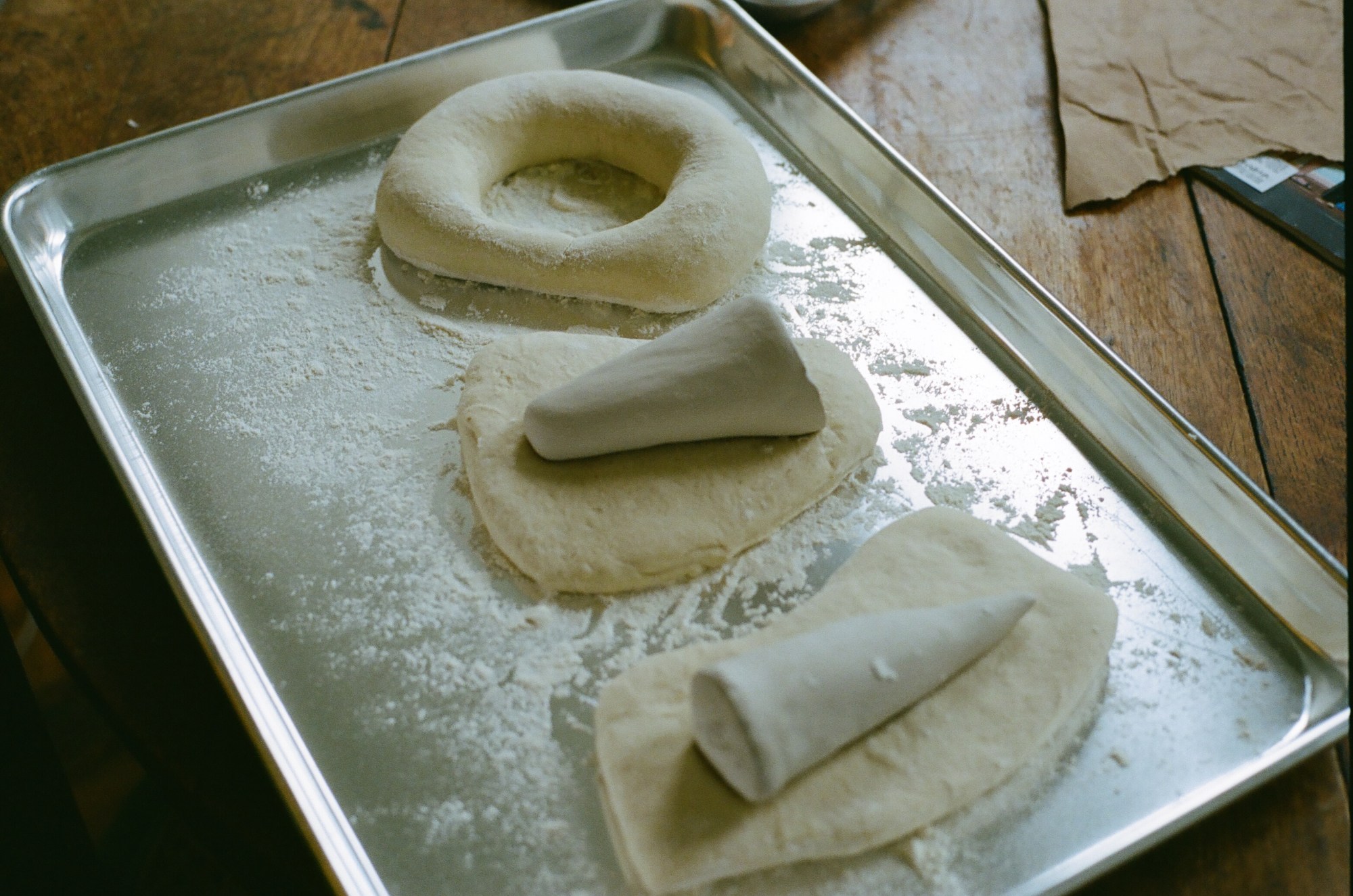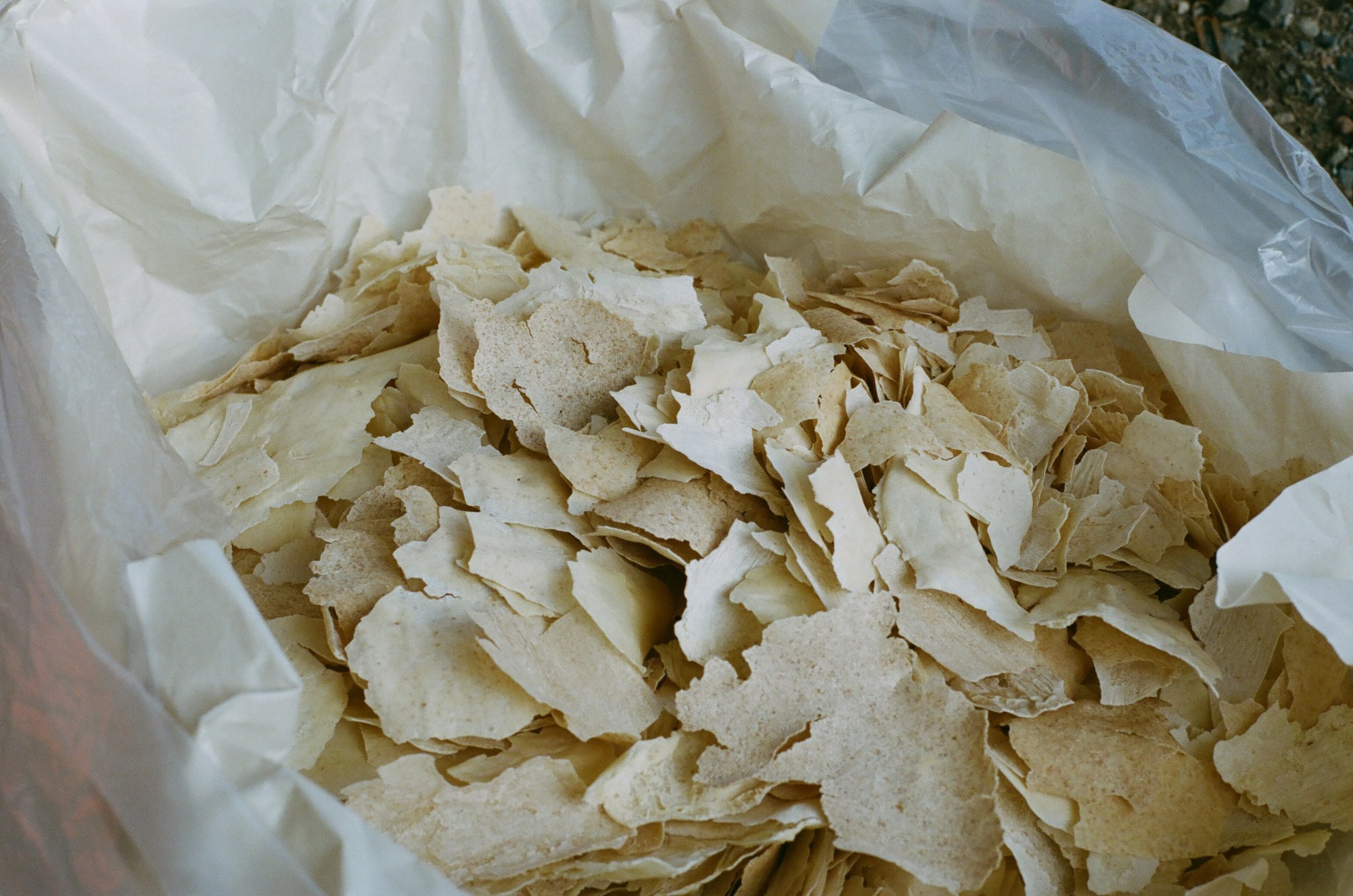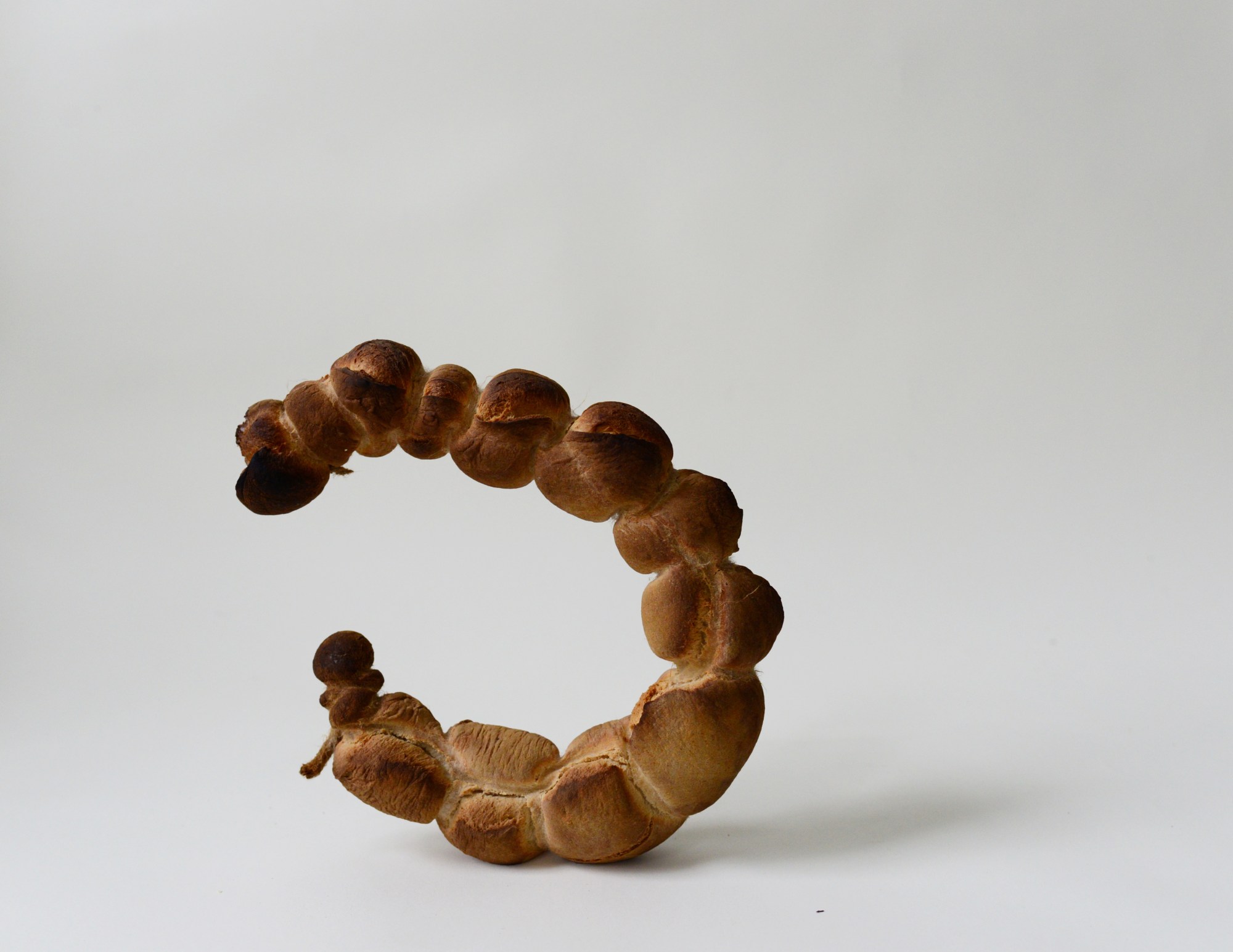When you think about bread, art is not usually the first thing that comes to mind. That is, unless you’ve spotted the work of baker-turned-artist Lexie Smith, or stumbled on her Instagram. Creating edible installations, sculptures and prose with — and about — bread, the New York-based Smith uses food not only as a medium, but also as a means of exploring culture. For her, there’s nothing more telling about a society than the way they engage — or don’t engage — with bread. “It holds within it a large spectrum of the human experience,” she says.
Growing up, Smith was always into baking. But it wasn’t until after college, while she was working a variety of restaurant jobs around the city, that she realized she could bake bread and create art from it. But don’t expect her to be selling off her pieces, or taking part in any group shows.
“For me, it’s as much about not creating waste, as it is not being attached to some flippant product of my hands that I really try not to attach ego to,” she explains. Plus, “if I had it my way, I would only cook naturally leavened flatbread over an open flame all day, everyday,” she says. Or, play with Samuel, her pet snake.
Below, the artist sounds off on gluten, being part of the art world and her next project — a Wikipedia for bread.
How do you describe what you do?
I have a notoriously difficult time describing what I do. I have the tendency to avoid this sort of reductionist name-giving that we’re very inclined towards in this day in age. That said, if I had to succinctly describe it, I would say: I write and I make art, with bread often as a theme and medium.
What are you working on right now?
Right now, I’m focusing more on words than on actually making three-dimensional, consumable objects. I’ve been doing a lot of research and writing about bread, and I have a website that I’m working on. Part of me does love being known as “The Bread Lady,” because one of my goals at the start was to question why bread was being vilified in mainstream media, and the food industry, and to sort of bring it back into favor. We have tools we’ve never had before— I mean, in a very gross way — and it’s become really pretty easy to turn something into an aesthetic trend.
So, if we want to screw with the ability to put a sum on the scale of the zeitgeist, and if everyone is hating on this thing that has kept civilization afloat for thousands of years, what happens if I use photography and social media to sway that back, and what are the conversations that arise around it? I know there’s a lot of political, historical and social cues that can come from this thing that happens to be something people love, but don’t often allow themselves to eat in the Western world. It’s incredibly ripe and full for dissecting, so in my silent moments, I always come back to bread as a place to launch my thinking.

So, that’s where your interest in bread initiated, but on a larger scale — why do you choose to use it not only as a medium, but as something from which most of your work stems?
Bread is a really universal thing, but also a really intimate symbol that’s at once representative of both completely different sides of the economic scale. So, it represents the linguistics and actuality of money, just in the color of bread, and then all the way down to being the ultimate symbol of the peasant masses.
Right, and also the privilege to be able to choose not to eat bread.
Exactly. If you look at the differences between the so-called third world and America, and the ways that bread is represented through art and culture, and through diet, what does that imply about the liberties we’re afforded? It’s just a really amazing barometer for social change. I guess you could say that about other things, like paint or sand, if you have an art history degree and can bullshit your way through anything, but the thing about bread is, pretty much everyone loves it. That’s why all of this started—because I love bread and when I started sharing about it online, the response I got really surprised me. Then, with the travel ban, I realized this could be an excellent tool to talk about both the similarities and differences that can be represented within one object, and do it in a way that is probing, but also nurturing, and actually feeds people.

Do you think “food art,” or bread, has a place in the industry as something non-edible, or strictly as art?
Lately, I’ve been seeing a lot of images that use food as props, and it’s become this super trendy accessory or art piece. But I think it’s a pretty empty gesture, and implies a lot of waste. So, I don’t ever want to make bread so that it can be commodified in a setting outside of feeding people, and I also never want to use it as an accessory to get likes on the internet.
What do you think it is about bread, as a medium, that allows you to express yourself in a way other mediums don’t? But also, how is that process different from when you’re engaging with it through other mediums, like writing, or creating a sculpture from your loaves?
There’s a couple things: the reason why I started doing anything sculptural and less traditional with bread-making was because I had carved out a little bit of a space in the baking world, which was a world I never felt comfortable or had any desire to be in. No hate to the amazing bakers out there, but I just didn’t know how I ever got there. I mean, I had loved baking, always. But I started baking professionally because it was a way to make money, and once I was in that world, I didn’t feel entitled to make anything else. Being involved in this very hip downtown art scene when I was in my late teens and early 20s, I was suddenly surrounded by all these kids who were like, ‘I’m an artist! I have a studio, even though I’m only 18.’ I was just like, ‘What? Okay, I’m definitely not one,’ so I didn’t feel entitled to making anything that could be considered art, even though that was exactly what I wanted to do.
At some point, I got asked to be a part of a group show, and I had kind of been oscillating between working in the art world, doing graphic design, and doing food. So, I was just like, ‘Fuck it. I’m going to make bread and put it in a gallery.’ It ended up being completely freeing because I realized instantly that the medium itself was so evocative—I didn’t need to impose structure or aesthetic onto it. Also, it just felt really honest for me to be making things with bread.

One thing I didn’t really think about that you mentioned, is the way Western culture has really started to vilify bread. Everyone is gluten-free now, and carbs are just accepted as being bad. It’s like, bread is the one food—
It’s the whipping boy.
But it’s also weird, because food has gotten trendy. Like, bread is out, bacon is in. Same with avocado.
It’s like a pendulum swinging. There was a time when fat was bad, and bacon and avocado would have been off the table. But now it’s bread, specifically. The way the world works is that where the wealthy go, everyone else will follow and then the wealthy will move away from it again. So, I do believe that’s what going to happen with the gluten-free industry eventually, but as it stands right now, the gluten-free industry is huge. It’s a billion dollar industry that consists of products that are way worse for your body than real bread is. But everyone is looking for an instant cure, or a scapegoat. So, it’s like, ‘I don’t want to feel tired, and sad, and bloated anymore. I’ll just stop eating bread!’ If that helps you, that’s fucking great, even if it’s all in your head. But I do think it’s important to ask questions. Like, ‘Where did this idea from? Who should we actually be looking to blame, instead of this item that has kept civilization going for fourteen thousand years?’

Right, and I think what you’re doing forces people to look at bread differently — whether from a consumption standpoint, or as art.
I hope so. I mean, it’s definitely a hot button topic. But my goal is to make people look at it twice. I’ve had a lot of people say, ‘I really want bread but I don’t want to eat it. What do I do?’ and then I can talk to them about ways to look for sources that will make them feel better, and have them question where their food is coming from, and where their money is going, and also have conversations about a million other things, like family, and memory, and culture. I also think now is the time for it because if you’re on a diet, and you’re not eating sugar, and you see a chocolate cake, you’re like, ‘I’m fucking obsessed with this cake.” It’s just so fetishized. So, I’m like, ‘Cool, let’s talk about it, but let’s also talk about why you’re not eating it.’
What about your project Bread on Earth. Can you tell me what it is?
Right now, it lives as a website, but it’s also a project that I consider to be the dumping ground for all of my explorations relating to bread. One of the end goals of it — even though I don’t think of it as something that will ever be finished, but it is the reason why I built the website — is this thing that I’ve kind of coined, “The Bread Web,” which would be a navigable map that’s a comprehensive guide to as many regional bread types that are possible to collect from around the world in one space. I’ve never been able to find anything like that — it doesn’t really exist, and the options are endless. That’s kind of the point—that there is no ending, but ideally, I’d love to have as many of them in one space as possible. So, if you have a bread in Romania that’s really similar to a bread in Georgia, and you can kind of witness the similarities and differences between them, and have that create a web all around the world — my idea is to show those spaces between, and the links that connect the global culture, like a database.

Like a Wikipedia for bread, that’s also a map. When I first reached out to you, you said you were in a transitional phase and you were starting to work on stuff other than bread. So, what’s next for you?
I don’t know, I’m just really bad at sticking with something that’s working. I’ve had an absolutely incredible and surprising response to the work I do with bread, and I’m really grateful for it, but that’s basically a guarantee that I’m going to try my hardest to destroy or abandon it. I’m pushing against that instinct, though, because ultimately, bread is the only thing I’ve stuck to for long periods of time. At the same time, I just kind of felt like I had to move backwards, and protect it a little bit, because it’s pretty easy to become a caricature of yourself. Like, ‘Oh, here’s the bread lady. Can you hold this bread next to your face?’ So, I just felt the need to push back a little bit and take some time to remember why I have been so compelled and inspired by the medium. But honestly, everything I work on always tends to bring me back to bread — whether I’m making sculptural visuals, or writing about it.
